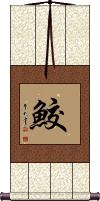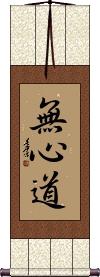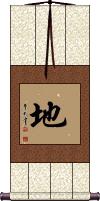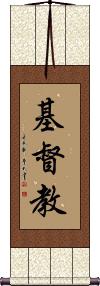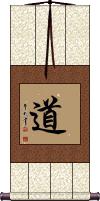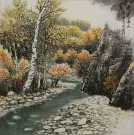Many custom options...
And formats...

Base in Chinese / Japanese...
Buy a Base calligraphy wall scroll here!
Personalize your custom “Base” project by clicking the button next to your favorite “Base” title below...
鮫 means shark in Japanese in a single Kanji. 鮫 is often used in Japanese along with a Kanji adjective. This would be the base Kanji for titles like “Tiger Shark,” “Hammerhead Shark,” “Thresher Shark,” etc.
This character can be pronounced in Chinese but is only used in combination with other characters to create shark-related titles. This Kanji is best if your audience is Japanese.
Mushindo
Earth
(Used in Japanese version of five elements)
地 is the single-character element and title of the planet Earth in Chinese, old Korean Hanja, and Japanese Kanji.
Because this is a single character, the definition is a little ambiguous and can have many meanings depending on the context in which it is used. These meanings include: earth, ground, land, soil, dirt, place, territory, bottom (of a package, book, etc.), earth (one of the Japanese five elements), the region in question, the local area, skin, texture, fabric, material, weave, base, background, one's true nature, narrative (i.e. descriptive part of a story), real life, actuality, etc.
In Japanese, this Kanji can be pronounced several ways, including chi, ji, tsushi, or tsuchi.
地 is also an element of the Japanese version of the five elements (the original Chinese version uses a different version of earth).
Christianity / Christian
基督教 is the Chinese, Japanese and Korean word for “Christianity.”
Just as in English, this word is often used to mean “Protestant” but includes Catholics in the true definition.
It is the word used to refer to the whole “Christian religion” or “Christian Faith,” and therefore, it can be translated as “Christianity.” However, used as an adjective in regard to a person, it would translate as “Christian.” But more like saying, “His religion is Christianity,” rather than a noun form.
If you break it apart, the characters mean Base/Foundation Leading/Supervising Religion/Teaching. It makes more sense in Japanese, Chinese, and Korean. The first two characters together are translated as “Christ.” So you can also say this means “Christ's Religion” or “Christ's Teachings” when directly translated, or in reverse, “The Religion of Christ” or “The Teaching of Christ.”
Notes: The last character has a slight difference in one stroke - however, in calligraphic form, this will not be apparent. This entry can easily be read by any Korean person who knows Hanja characters (Chinese characters used in Korean).
See Also: Jesus Christ | God of Abraham
Daoism / Taoism
Literally: The Way or Road
道 is the character “dao” which is sometimes written as “tao” but pronounced like “dow” in Mandarin.
道 is the base of what is known as “Taoism.” If you translate this literally, it can mean “the way” or “the path.”
Dao is believed to be that which flows through all things and keeps them in balance. It incorporates the ideas of yin and yang (e.g. there would be no love without hate, no light without dark, no male without female.)
The beginning of Taoism can be traced to a mystical man named
Lao Zi (604-531 BC), who followed, and added to the teachings of Confucius.
More about Taoism / Daoism here.
Note that this is pronounced “dou” and sometimes “michi” when written alone in Japanese but pronounced “do” in word compounds such as Karate-do and Bushido. It's also “do” in Korean.
Alternate translations and meanings: road, way, path; truth, principle province.
Important Japanese note: In Japanese, this will generally be read with the road, way, or path meaning. Taoism is not as popular or well-known in Japan so Daoist/Taoist philosophy is not the first thing a Japanese person will think of when they read this character.
See our Taoism Page
Kansei Engineering / Sense Engineering
In short, 感性工學 or Kansei engineering involves collecting data on human experiences with a product and then designing or engineering improvements based on those experiences or “senses.”
Some may define Kansei as “engineering around the human experience.”
There is a lot more to know about Kansei, but if you are looking for this word, you probably already know the big picture.
Note: This term is very new in China and is only used by businesses, factories, and engineers that are implementing TQM principles. While the characters have the same base meaning in both languages, this is a Japanese title that flows back into the Chinese language (in history, most things flowed from China to Japan). To a Chinese person unfamiliar with this concept, they may interpret this as “sense vocational studies,” which doesn't make much sense. You may have to explain the intended meaning to some Chinese viewers. But that can make it a great conversation piece.
Kansei is also a newer term in Korean and is only used in certain parts of the industry, with the definition of “Sensory Engineering.” Not yet in widespread use in Korea.
Above is the modern Japanese version of this title. The last character has a Traditional Chinese version, making this 感性工學 instead of 感性工学. If you want the Traditional Chinese version, please include special instructions or email me so that I make sure the calligrapher writes the version you want.
See Also: Kaizen
This in-stock artwork might be what you are looking for, and ships right away...
Gallery Price: $300.00
Your Price: $128.88
These search terms might be related to Base:
Always in My Heart
Beautiful Heart / Beautiful Mind
Beautiful Heart / Beautiful Spirit
Benevolent Heart
Brave Heart
Buddha Heart / Mind of Buddha
Chastity / Pure Heart
Compassionate Heart / Benevolent Heart
Confidence / Faithful Heart
Doing Good is the Greatest Source of Happiness
Even the 100-Foot Bamboo Can Grow One More Foot
Failure is the Origin of Success
Follow Your Heart
Forever in My Heart
God in the Glorious Center of Heaven
Good Heart
Heart / Mind / Spirit
Heart and Soul
Heart of a Warrior
Heart of a Warrior / Samurai Heart
Heart of Aikido
Heart of Judo
Heart Sutra
Heart Sutra Mantra
Heart Sutra Title
Home is Where the Heart Is
Independent Spirit / Independent Heart
Inner Heart / Inner Soul
Iron Heart
Just as Liquor Turns a Face Red, Gold Turns a Heart Black
Lion Heart
Listen to Your Heart / Follow Your Heart
Loving Heart / Compassion
Loving Heart / One’s Love
Merciful Heart / the Light From a Buddha Mind
One Heart / One Mind / Heart and Soul
Peaceful Heart
Peaceful Heart / Peace of Mind / Calm Mind
Prideful Mind / Self-Respecting Heart
Pure Heart
Respectful Heart
Set Your Heart Ablaze
Sincere Heart
Sisters at Heart
Soul Mates at Heart
Strong-Willed / Strong of Heart
Tao / Dao of the Heart / Soul
The Foundation of Good Conduct
Thinking Heart
Tiger Heart
To a Willing Heart, All Things Are Possible
True Heart
Trust Your Heart
Warrior’s Heart
Whole Heart
With All the Strength of Your Heart
Work Together With One Heart
You Are Always in My Heart
Zen Heart / Zen Mind
Not the results for base that you were looking for?
Below are some entries from our dictionary that may match your base search...
| Characters If shown, 2nd row is Simp. Chinese |
Pronunciation Romanization |
Simple Dictionary Definition |
馬蘭 马兰 see styles |
mǎ lán ma3 lan2 ma lan |
More info & calligraphy: Marlen |
リート see styles |
riido / rido リード |
More info & calligraphy: Riet |
低 see styles |
dī di1 ti tei / te てい |
low; beneath; to lower (one's head); to let droop; to hang down; to incline (prefix) low (level, value, price, etc.) To let down, lower. |
僻 see styles |
pì pi4 p`i pi mineo みねお |
(bound form) remote; out of the way; off-center; eccentric (noun or adjectival noun) (1) (archaism) secluded; (noun or adjectival noun) (2) (archaism) leaning to one side; (personal name) Mineo Perverse, base, depraved; partial, prejudiced; rustic, secluded. |
卑 see styles |
bēi bei1 pei hi |
low; base; vulgar; inferior; humble Low, inferior; translit. p, pi, v, vy, m. |
台 see styles |
tái tai2 t`ai tai dai だい |
(classical) you (in letters); variant of 臺|台[tai2] (n,n-suf) (1) stand; rest; base; pedestal; platform; table; holder; support; rack; (2) setting (of a gem); mounting; (3) (See 台木・1) stock (in grafting); (counter) (4) counter for machines and vehicles; (suffix) (5) (after a rounded value) level (e.g. price level); mark; range; decade (of one's life); (suffix noun) (6) tall building (with a fine view); (observation) platform; (suffix noun) (7) (in place names) plateau; heights; (surname) Dai A flat place, platform, plateau, terrace; an abbrev. for 臺 and for 天台 Tiantai, hence 台嶽 the Tiantai mountain; 台宗; 台家 its 'school'; 台徒 its disciples; 台教; 台道 its doctrine, or way. |
合 see styles |
hé he2 ho takagou / takago たかごう |
to close; to join; to fit; to be equal to; whole; together; round (in battle); conjunction (astronomy); 1st note of pentatonic scale; old variant of 盒[he2] (1) gō; traditional unit of volume, approx. 180 ml; (2) gō; traditional unit of area, approx 0.33 square meters; (3) one-tenth of the distance from the base to the summit of a mountain; (4) {astron} (See 衝・3) conjunction; (5) (See 合計) sum; total; (6) {phil} (See 総合・1,正反合) synthesis (in dialectics); (7) minor premise (in hetuvidya); (counter) (8) counter for covered containers; (counter) (9) counter for matches, battles, etc.; (surname) Takagou Bring together, unite, unison, in accord. |
圭 see styles |
guī gui1 kuei misaki みさき |
jade tablet, square at the base and rounded or pointed at the top, held by the nobility at ceremonies; sundial; (ancient unit of volume) a tiny amount; a smidgen; a speck (female given name) Misaki |
基 see styles |
jī ji1 chi motoji もとじ |
(bound form) base; foundation; (bound form) radical (chemistry); (bound form) gay (loanword from English into Cantonese, Jyutping: gei1, followed by orthographic borrowing from Cantonese) basis; foundation; origin; source; (personal name) Motoji foundation |
塁 see styles |
lěi lei3 lei rui るい |
Japanese variant of 壘|垒 (1) {baseb} base; bag; sack; (2) fortress; stronghold; (male given name) Rui |
壘 垒 see styles |
lěi lei3 lei |
rampart; base (in baseball); to build with stones, bricks etc |
幹 干 see styles |
gàn gan4 kan motoki もとき |
tree trunk; main part of something; to manage; to work; to do; capable; cadre; to kill (slang); to fuck (vulgar); (coll.) pissed off; annoyed (tree) trunk; (arrow) shaft; (tool) handle; backbone; base; (given name) Motoki |
底 see styles |
dǐ di3 ti soko そこ |
background; bottom; base; end (of the month, year etc); remnants; (math.) radix; base (1) {math} base (logarithmic, exponential, number system); radix; (2) {geom} base (triangle, cone, cylinder, etc.); (3) type; kind; extent; degree; (surname) Soko Bottom, basis; translit. t, d, dh. |
座 see styles |
zuò zuo4 tso za ざ |
seat; base; stand; (archaic) suffix used in a respectful form of address, e.g. 师座|师座[shi1 zuo4]; CL:個|个[ge4]; classifier for buildings, mountains and similar immovable objects (1) seat; place; (2) position; status; (3) gathering; party; company; atmosphere (of a gathering); (4) stand; pedestal; platform; (5) (hist) trade guild; (suffix) (6) attaches to the names of constellations; (suffix) (7) attaches to the names of theatres, cinemas and theatrical troupes; (suf,ctr) (8) (See 里神楽) counter for theatres, deities, Buddhist images, tall mountains, and satokagura songs; (surname) Za āsana. A seat; throne; classifier of buildings, etc. |
枓 see styles |
dǒu dou3 tou |
square base for Chinese flagstaff |
梺 see styles |
fumoto ふもと |
(irregular kanji usage) (kana only) foot (of a mountain or hill); bottom; base; (place-name) Fumoto |
榰 see styles |
zhī zhi1 chih |
base of pillar; prop |
礎 础 see styles |
chǔ chu3 ch`u chu motoe もとえ |
foundation; base foundation stone; cornerstone; (female given name) Motoe |
蘖 see styles |
niè nie4 nieh getsu もやし |
new shoot growing from cut branch or stump (irregular kanji usage) (kana only) bean sprouts; (kana only) sprouts from a stump; buds from the base of a tree A shrub, tree stump, etc., translit. g, ga, gan. |
袂 see styles |
mèi mei4 mei tamoto たもと |
sleeve of a robe (1) (See 袂を分かつ) sleeve (esp. of a kimono); pocket of sleeve; (2) vicinity (esp. of a bridge); (3) foot of a mountain; base of a mountain |
跋 see styles |
bá ba2 pa batsu ばつ |
postscript; to trek across mountains epilogue; postscript; envoi Trudge, tread on, travel; heel, base; a summary; translit. pa, ba, bha, va; cf. 波, 婆, 簸. |
進 进 see styles |
jìn jin4 chin tomoko ともこ |
to go forward; to advance; to go in; to enter; to put in; to submit; to take in; to admit; (math.) base of a number system; classifier for sections in a building or residential compound (personal name) Tomoko Advance, progress, enter. |
鄙 see styles |
bǐ bi3 pi hina ひな |
rustic; low; base; mean; to despise; to scorn countryside; rural areas; (female given name) Hina I (self-deprecatory) |
鹼 碱 see styles |
jiǎn jian3 chien |
(chemistry) base; alkali; soda |
麓 see styles |
lù lu4 lu roku ろく |
foot of a hill (kana only) foot (of a mountain or hill); bottom; base; (surname) Roku |
一合 see styles |
ichigou / ichigo いちごう |
(1) (See 合・1) one gō (approx. 180 ml); (2) (See 合・2) one gō (approx. 0.33 square meters); (3) (See 合・3) one-tenth of the distance from the base to the summit of a mountain; (place-name) Ichigou |
一塁 see styles |
ichirui いちるい |
(1) (baseb) first base; (2) (baseb) (abbreviation) first baseman; (3) one fort |
一直 see styles |
yī zhí yi1 zhi2 i chih kazunao かずなお |
straight (in a straight line); continuously; always; all the way through {baseb} lining out to first base; (given name) Kazunao |
三塁 see styles |
sanrui さんるい |
(baseb) third base |
三盗 see styles |
santou / santo さんとう |
{baseb} stealing third base |
Click here for more base results from our dictionary
The following table may be helpful for those studying Chinese or Japanese...
| Title | Characters | Romaji (Romanized Japanese) | Various forms of Romanized Chinese | |
| Shark | 鮫 鲛 | same | jiāo / jiao1 / jiao | chiao |
| Mushindo | 無心道 无心道 | mu shin dou mushindou mu shin do | ||
| Earth | 地 | chi / ji / tsushi / tsuchi | dì / di4 / di | ti |
| Christianity Christian | 基督教 | kirisutokyou kirisutokyo | jī dū jiào ji1 du1 jiao4 ji du jiao jidujiao | chi tu chiao chituchiao |
| Daoism Taoism | 道 | michi / -do | dào / dao4 / dao | tao |
| Kansei Engineering Sense Engineering | 感性工學 感性工学 | kansei kougaku kanseikougaku kansei kogaku | gǎn xìng gōng xué gan3 xing4 gong1 xue2 gan xing gong xue ganxinggongxue | kan hsing kung hsüeh kanhsingkunghsüeh |
| In some entries above you will see that characters have different versions above and below a line. In these cases, the characters above the line are Traditional Chinese, while the ones below are Simplified Chinese. | ||||
Successful Chinese Character and Japanese Kanji calligraphy searches within the last few hours...
